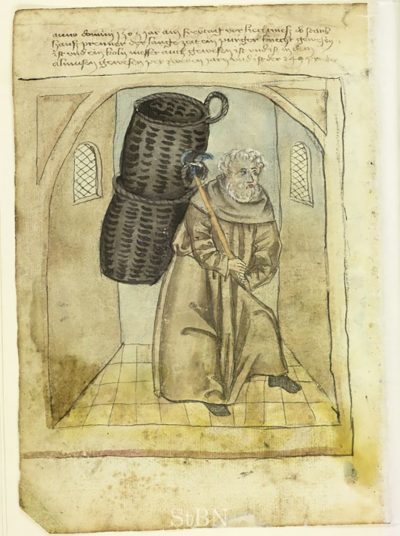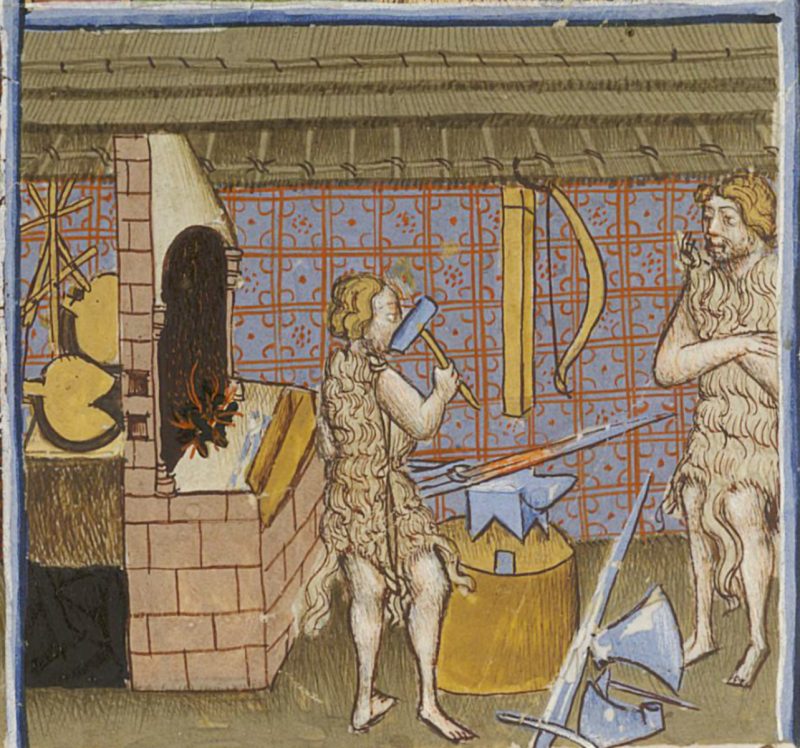
Black pigments made of coal appear in artists’ treatises from the late fifteenth century onwards. They are frequently mentioned in seventeenth-century English sources, when the famous English sea coal was introduced to domestic life, as well as by Flemish, Dutch and French authors. Coal is a sedimentary rock, formed from accumulation of plant material in oxygen-deficient swamp waters. Over millions of years, the plant deposits moved into ever deeper layers of the earth’s crust, where they were exposed to high pressure and increased temperatures. This led to carbonization processes. The deeper the coal is deposited, the higher the carbon content . Besides carbon, oxygen and hydrogen, also sulfur and nitrogen are major elements present in coal. Due to the content of sulfur, it’s fumes emit an unpleasant smell during burning. Within Burgundian territory there was an important natural source of coal: the deposits of the Sambre-Meuse valley, which stretched from Mons in the County of Hainaut, via Charleroy and Namur to the Prince-Bishopric of Liège.
> Luyker zwart Quote 18
“Luijcker Swardt. Men maekt oock goet swardt van steencoolen alsmen / die well vrijfft met schoon water, ende verwercken met / schoon gomwater dit is seer bequaem swardt om wullen / laecken mede aen te legghen, ende wordt ghenoemdt smeko / lin swardt.”[1]
Liège (dut: Luik) is the eponym for the pigment Luyker zwart, which appears as a black pigment for limning in two seventeenth-century manuscripts; the cited one from Antwerp and another textually closely related manuscript from Amsterdam.[2] Coal was mined near the city of Liège already in the thirteenth century, it must thus have been accessible to illuminators active in Burgundian regions. However, the coal’s sulfur content causes interactions with sulfur-sensitive pigments like lead white, inducing color changes. Such decay reactions were known to illuminators who avoided combinations of susceptible pigments.
> Coal Figures 32a, 32b

At the end of the fifteenth century coal is mentioned for preparation of a black printing ink in a compilation of artists’ recipes written in Oostmiddelnederlands: “So wrijft steynkolen myt vasser”, suggesting that it was known and available in the northern territories. [3]
> Sea coal Figures 33a, 33b

A specific type of coal, sea coal, is a British phenomenon. It is found in the north east of England, especially in the region around Newcastle. Here, exposed to the seashore, coal seams outcrop on the beaches, which explains the name. Adjacent to the coastal area, deposits of coal were found close to the surface. Already in Roman times coal was mined in England, which later fell into oblivion. In the thirteenth century, coal was rediscovered in areas where seawater bared coal deposits. Surface deposits were exploited on larger scale from the fourteenth century onwards, especially around the river Tyne. Initially used by black smiths and lime burners, it replaced wood and charcoal as domestic fuel in English coal districts in the fifteenth century.[4] During the sixteenth century, a considerable demand for coal had sprung up on the continent, where especially French metal processing artificers were dependent on English coal exports.[5] The final transition from wood to sea coal as fuel in domestic London took place during the seventeenth century. This was first met by quite an opposition: ”the nice dames of London would not come into any house or room when sea coals were burned, nor willingly eat of the meat that was either sod or roasted with sea coal fire”[6] The disturbing smoke and smell of sea coal fires was an ongoing annoyance. Not only for people, but concern was raised with regard to the permanence of painted works: “for the colors themselves may not endure some Ayres, especially the Sulphurous Ayers of Seacoal”.[7] This warning is not yet included in the first edition of Bates “The Mysteries of Nature and Art” of 1634, but does appear 20 years later in the third edition, when sea coal was established as a commonplace fuel in London. With regard to these developments, especially with the increased availability of sea coal, it is not surprising that the late sixteenth century and especially the seventeenth century mark the period when it first appears in sources as a black pigment.

> Smith coal Figure 34, Quote 19 / Color sample 8
“Smeekoole swart. Het smeekole swart is niet / anders als het geen men van / den smis of brouwers kool / met schoon reegenwater / komt tevrijve dat men met / reedelijk kort gom water moet tempereren en / is dan reedelijk vloeijbar / om op verscheije mannieren / tegebruijke gegellijck als hier / tesien is.”[8]
Several seventeenth-century sources mention smith coal, for instance Goeree included it in his list of watercolors of 1670.[9] It might refer to both charcoal and coal, since smiths use both. In the case of Mayerne’s manuscript it is applied as a substitute term for Luyker black, coal. Probably seventeenth-century attention was owed to the fact that coal was easier to obtain.
[1] “Black from Luik/Liège. You can also make good black coal if you grind it well with clean water / and process it with clean gum water. This is very good black for painting woolen fabrics and is also called blacksmith-coal black.” Anonymous. 1600-1650. Schoone consten ende secreten, Rome, Bibliotheca Apostolica Vaticana, Ms. Lat. 7279: fol. 24v, 25r. https://digi.vatlib.it/view/MSS_Vat.lat.7279, last accessed 9 November 2020; here cited after Braekman. 1994. Antwerpse ‘consten ende secreten’ voor verlichters en ‘afsetters’ van gedrukte prenten: p. 116.
[2] Veen. 1650-1687. De Wetenschap en[de] Manieren: Without page.
[3] “So grind coal with water”, Hs.1028/1959 8°. end of fifteenth century – beginning of sixteenth century, Stadtbibliothek Trier: fol. 27r. In: Braekman. 1997. Warenkennis, Kleurbereidingen Voor Miniaturisten En Vakkennis Voor Ambachtslui (15de E.): 138, rec. 37.
[4] Galloway. 1882. A history of coal mining in Great Britain: p. 11ff.
[5] Galloway. 1882. A history of coal mining in Great Britain: p. 20 ff.
[6] Galloway. 1882. A history of coal mining in Great Britain: p. 24 cites Howes 1631 without providing a reference.
[7] Bate. 1654. The Mysteries of Nature and Art: p. 163.
[8] “Smith coal is nothing else than that of the blacksmith or brewer’s coal; and grind it with clean rainwater; that one must temper with fairly short gum water and is then reasonably fluid to use in several ways, as seen here.” Boogert. 1692. Klaer lightende Spiegel der Verfkonst, Bibliothèque Méjanes in Aix-en-Provence, MS 1389 (1228): Without page number.
[9] Goeree. 1670. Verlichterie-Kunde: p. 3. https://hdl.handle.net/1874/188396.
[1] "Black from Luik/Liège. You can also make good black coal if you grind it well with clean water / and process it with clean gum water. This is very good black for painting woolen fabrics and is also called blacksmith-coal black." Anonymous. 1600-1650. Schoone consten ende secreten, Rome, Bibliotheca Apostolica Vaticana, Ms. Lat. 7279: fol. 24v, 25r. https://digi.vatlib.it/view/MSS_Vat.lat.7279, last accessed 9 November 2020; here cited after Braekman. 1994. Antwerpse ‘consten ende secreten’ voor verlichters en ‘afsetters’ van gedrukte prenten: p. 116.
[2] Veen. 1650-1687. De Wetenschap en[de] Manieren: Without page.
[3] “So grind coal with water”, Hs.1028/1959 8°. end of fifteenth century - beginning of sixteenth century, Stadtbibliothek Trier: fol. 27r. In: Braekman. 1997. Warenkennis, Kleurbereidingen Voor Miniaturisten En Vakkennis Voor Ambachtslui (15de E.): 138, rec. 37.
[4] Galloway. 1882. A history of coal mining in Great Britain: p. 11ff.
[4] Galloway. 1882. A history of coal mining in Great Britain: p. 11ff.
[6] Galloway. 1882. A history of coal mining in Great Britain: p. 24 cites Howes 1631 without providing a reference.
[6] Galloway. 1882. A history of coal mining in Great Britain: p. 24 cites Howes 1631 without providing a reference.
[8] “Smith coal is nothing else than that of the blacksmith or brewer's coal; and grind it with clean rainwater; that one must temper with fairly short gum water and is then reasonably fluid to use in several ways, as seen here.” Boogert. 1692. Klaer lightende Spiegel der Verfkonst, Bibliothèque Méjanes in Aix-en-Provence, MS 1389 (1228): Without page number.
[9] Goeree. 1670. Verlichterie-Kunde: p. 3. http://hdl.handle.net/1874/188396.